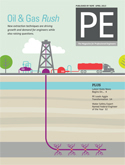April 2013
NSPE TODAY: POLICY PERSPECTIVES
Heard in Washington
Engineering news from around the nation's capital.
NSPE Pushes for Budget Agreement
In early March, NSPE sent a letter to President Obama, Speaker of the House John Boehner, and Senate Majority Leader Harry Reid, about its deep concern over the federal budget sequester. NSPE President Dan Wittliff, P.E., F.NSPE, wrote that the federal government's inability to resolve the current budget impasse could jeopardize the critical work of PEs in the public and private sectors and impede their efforts to protect the public health, safety, and welfare.
Wittliff pointed specifically to the outstanding work of the federal engineers who were honored on February 21 at the Federal Engineer of the Year Award ceremony in Washington, D.C. To prevent the possibility that their work is jeopardized, Wittliff urged all sides to quickly resolve their differences.
Coalition Stands Up for QBS
A planned study of the J. Edgar Hoover FBI Building and a solicitation for A/E services recently caught the attention of the Council on Federal Procurement of Architectural and Engineering Services. The council, of which NSPE is a member, contacted the General Services Administration in early February to inform the agency that its solicitation did not comply with the Brooks Act. The law requires federal agencies to select A/E services based on competence and qualification, subject to price negotiation with the most qualified firm.
NSPE has been a longtime proponent of qualifications-based selection, and NSPE Past President Chris Stone, P.E., F.NSPE, is serving as chairman of COFPAES.
After GSA was notified by COFPAES, GSA acknowledged the error and stated that the solicitation would be reissued in accordance with the Brooks Act.
Academy Celebrates 150 Years
The National Academy of Sciences turned 150 on March 3. The independent organization, which provides advice on matters relating to science, engineering, and medicine, was formed in 1863 when President Abraham Lincoln signed a congressional charter. One of its earliest studies helped the Civil War effort by improving compass navigation for the Union's fleet of ironclad warships.
The academy expanded to include the National Research Council in 1916, the National Academy of Engineering in 1964, and the Institute of Medicine in 1970.
Cybersecurity Framework
In 2008, when the National Academy of Engineering listed the 14 "grand challenges" for engineering in the 21st century, securing cyberspace was ranked number nine. Now the National Institute of Standards and Technology has taken the first step in developing a framework of voluntary standards and best practices to help industry reduce cyber risks to networks and computers that support the nation's critical infrastructure.
NIST is requesting ideas from critical infrastructure owners and operators, federal agencies, state and local governments, and standards-setting organizations. A stakeholders meeting was scheduled for April 3 at NIST headquarters. NIST's request for information can be found at www.nist.gov.
NAE, Iron Man Team Up
The National Academy of Engineering is hooking up with Hollywood to get teenagers interested in engineering. To hype the May 3 release of Iron Man 3, Discovery Science Center, Marvel Studios, and others are hosting a nationwide Inventor & Innovator Fair competition for 6th–9th grade students. Competitors are being asked to produce innovative, inventive projects based on themes from Iron Man 3—science, technology, engineering, and math-related concepts and practices. Some of those themes match those of NAE's Grand Challenges of Engineering, such as develop carbon sequestration methods, engineer better medicines, secure cyberspace, and engineer the tools of scientific discovery. For details, visit www.nae.edu.


 Volunteering at NSPE is a great opportunity to grow your professional network and connect with other leaders in the field.
Volunteering at NSPE is a great opportunity to grow your professional network and connect with other leaders in the field. The National Society of Professional Engineers (NSPE) encourages you to explore the resources to cast your vote on election day:
The National Society of Professional Engineers (NSPE) encourages you to explore the resources to cast your vote on election day:
